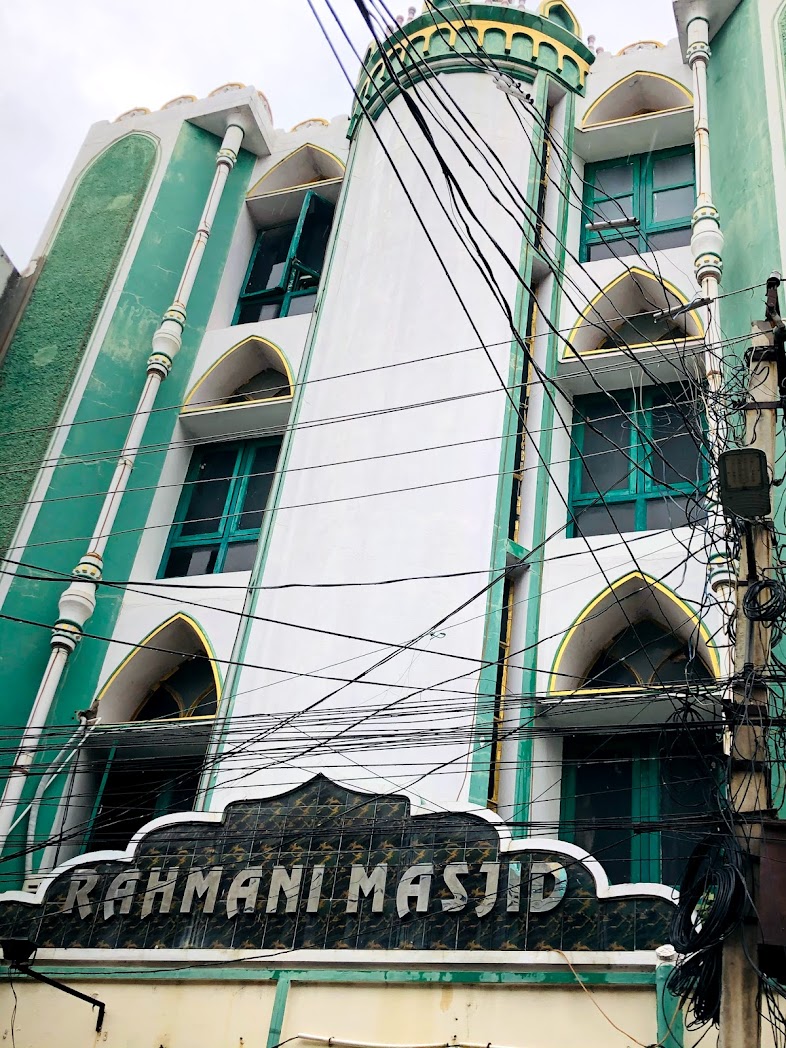.jpeg)
.jpeg)

The Rahmani Masjid in Tirupati, Andhra Pradesh, is a remarkable example of contemporary Islamic architecture that beautifully blends modern design with traditional elements. The mosque's striking appearance is characterised by its mint green and white colour scheme, which makes it stand out in the urban landscape of Tirupati. The facade of the Rahmani Masjid is a harmonious composition of geometric forms and Islamic motifs. The building rises several stories high, its vertical presence emphasized by slender white columns that run along the front. These columns, likely decorative rather than structural, add a sense of elegance and height to the building. One of the most notable features of the mosque is its use of pointed arches, a hallmark of Islamic architecture. These arches frame the windows and doorways, creating a rhythmic pattern across the facade. The arches are outlined in white against the green background, enhancing their visual impact and creating a sense of depth. The upper portion of the mosque is particularly ornate. A decorative parapet crowns the building, featuring a series of small dome-like structures painted in green and accented with gold. This intricate detailing adds a touch of grandeur and traditional Islamic aesthetics to the otherwise modern structure. Large windows with green frames allow natural light to penetrate the interior, likely creating a bright and airy atmosphere inside the prayer halls. The use of glass in these windows suggests a modern approach to mosque design, balancing the need for privacy with the desire for an open, welcoming space. At street level, the mosque's entrance is marked by a prominent sign bearing the name "RAHMANI MASJID" in stylized letters. This sign, set against what appears to be a dark marble or granite background, clearly identifies the building and adds a touch of sophistication to the entryway. The mosque's location in an urban setting is evident from the numerous electrical wires visible in front of the building. This juxtaposition of the serene, well-maintained religious structure against the backdrop of bustling city infrastructure highlights the mosque's role as a spiritual oasis within the urban environment. The Rahmani Masjid's modern design and meticulous upkeep suggest that it is a vital and active center for the Muslim community in Tirupati. Its presence in a city renowned for its Hindu temples, particularly the famous Venkateswara Temple, underscores the religious diversity of the region and the harmonious coexistence of different faiths. As a house of worship, the Rahmani Masjid likely serves multiple functions within the community. It undoubtedly hosts daily prayers, Friday congregations, and special services during Islamic holy months and festivals. The multi-story structure may also house educational facilities for Quranic studies, community meeting rooms, and possibly administrative offices for mosque management. The mosque's impressive architecture and prominent location indicate that it may also serve as a landmark for Muslims traveling to or through Tirupati. Its modern yet distinctly Islamic design makes it a bridge between traditional religious values and contemporary architectural expression. In conclusion, the Rahmani Masjid stands as a beautiful and significant religious edifice in Tirupati. Its striking design, prominent presence, and clear importance to the local community make it not just a place of worship, but also a symbol of the diverse and inclusive spiritual tapestry of modern India